MAIZE - POST HARVEST TECHNOLOGY
Nutrient composition of maize
The mature maize kernel is composed of four major parts: 1. Endosperm
(82 %), 2. Germ (12 %), 3. Pericarp (5 %) and 4. Tip cap (1 %)
1. |
Carbohydrate (%) |
66.2 |
2. |
Protein (%) |
11.1 |
3. |
Fat (%) |
3.6 |
4. |
Fibre (%) |
2.7 |
5. |
Minerals (%) |
1.5 |
-
Starch is the predominant carbohydrate of maize.
-
Prolamine is the predominant protein known as zein
-
Maize germ is rich in glutelin.
-
Enhanced lysine and tryptophan available in QPM hybrids.
-
Major lipids of maize are triglycerides, have high proportion of oleic acid and linoleic acid.
Health Benefits of Maize
- Rich in carotenoids which are known for their antioxidant activity.
- Maize protein benefit for vegetarians who do not consume animal meat.
- Gluten free food for people who have celiac disease and cannot consume wheat.
Processing of maize
- Maize is milled by a dry or wet process. In both processes, the germ is separated from the grain in order to extract and recover germ oil. The germ oil is a valuable product, but if allowed to remain a constituent of maize meal would lead to the development of rancidity.
Dry Milling
-
Grains are dry milled and employs roller mills and the process is somewhat similar to wheat milling. In dry milling, the object is to recover the maximum amount of grits with the minimum amount of flour, with the least possible contamination of died germ.
-
In India, maize is ground for whole meal atta in power-driven or hand¬ operated chakkis. The meal is sifted to remove fibre. In large-scale milling, maida and suji are produced. Grits are used in the preparation of porridge, to make corn flakes, as a brewing adjunct and to manufacture glucose by hydrolysis.
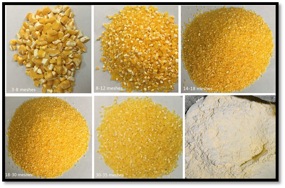
Corn Wet Milling
-
Pure starch, pure germ and feed are the basic products of corn wet milling. A list of these by products with their uses is given. Sufficient amount of moisture is added to the corn during stepping in the wet milling process in order to prepare the corn for subsequent degerming, grinding and separation operations.
Corn wet milling products
Product |
Feed / food uses |
Industrial uses |
Germ oil and meal foots |
Livestock |
Soap, glycerine, leather dressing, etc. |
Refined oil |
Salad and table oils, cooking oils, margarine |
Pharmaceuticals |
Steep water |
Yeast – food |
Phytic acid, inositol |
Gluten and hulls |
Livestock and Poultry feed |
|
Starch |
Corn starch, chewing gum, bakeries baking powder, brewing confectionary |
Textiles, laundry, paper and paper boxes, explosives, cosmetics, adhesives |
Syrup |
Bakery products, canned fruits, ice cream, confectionery, soft drinks, chewing gums, mixed syrups and jellies |
Textiles, leather tanning, pharmaceuticals, tobacco |
Sugar |
Bakery products, pharmaceuticals, jams and jellies, ice cream, canned foods, confectionary |
Rayon, tanning, fermentation brewing, vinegar, caramel colour, fermentation products, tobacco. |
Value Added Products
1.Corn flakes
- Cereal flakes are popular breakfast products and at present they are mostly made from corn. Ready to eat corn flakes are very popular, being crisp and friable in texture.
2. Traditional maize incorporated products
- Traditional foods are a rich heritage of India and offer wide diversity because of their origin in different regions and involvement of multidimensional culture. Our south Indian traditional foods like idli and dosa, rice was replaced with QPM maize upto 30% without altering the quality attributes at the same time the bioavailability of protein is enhanced.
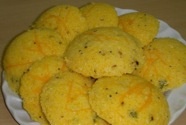 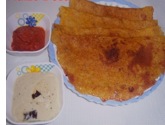
3. Extruded maize products- Noodles
- Extrusion cooking is one of the latest technologies used for the preparation of convenience food. Extruded products are mainly from wheat, as well as rice and from other sources. In order to meet the growing demand of population low cost maize flour was used in extruded products noodles by extrusion technology.
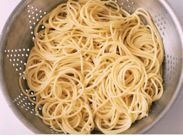
4.Expanded Snacks
-
Expanded snacks incorporating maize and other millets in the ratio of 80:20 could be processed by extruding through twin screw extruder. The maize extruded snacks provide good amount of protein, fibre and minerals with the shelf life of three months under flexible packaging material.
5.Pop corn
- Of the different types of corn, popcorn (Zea mays everta) is the only one that pops. There are various types of popping corn, but only the yellow and white varieties are available commercially. Popping of corn is due to the water in the kernel. As the kernal is heated, the water in the kernel is superheated and at the time of popping converts into steam, which provides the driving force for expanding the endosperm after the kernel ruptures.
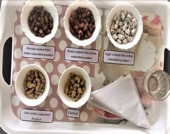
6. Papad
7. Maize based bakery products
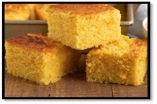
8.Maize based snack foods
-
Snacks contribute to an important part of many consumers’ daily nutrient and calorie intake. Consumers enjoy snack foods with good taste, flavour and pleasing textural mouth feel. Maize grits was used for processing of vada and pakoda at the level of 20% incorporation whereas for instant mixes like dosa mix 50% incorporated, adai mix (50%), pittu mix (75%). Hundred per cent of maize grits cereal be used for processing of kesari, uppuma and puliyotharai.
.
|






